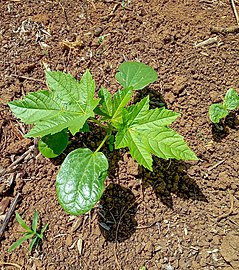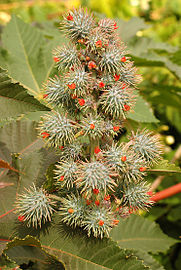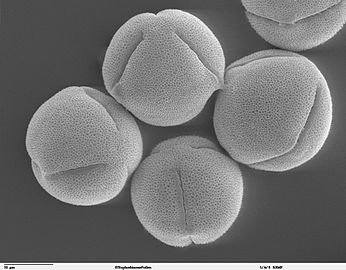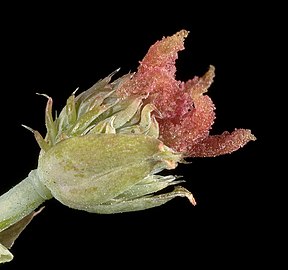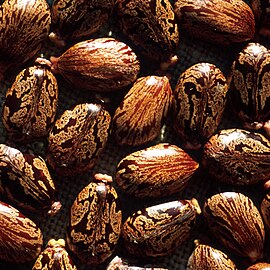Ricinus
| Ricinus | |
|---|---|
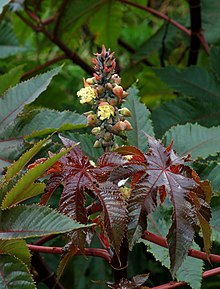
| |
| Leaves and inflorescence (male flowers below female flowers) | |
| Scientific classification | |
| Kingdom: | Plantae |
| Clade: | Tracheophytes |
| Clade: | Angiosperms |
| Clade: | Eudicots |
| Clade: | Rosids |
| Order: | Malpighiales |
| Family: | Euphorbiaceae |
| Subfamily: | Acalyphoideae |
| Tribe: | Acalypheae |
| Subtribe: | Ricininae |
| Genus: | Ricinus L. |
| Species: | R. communis
|
| Binomial name | |
| Ricinus communis L.
| |
Ricinus communis,thecastor bean[1]orcastor oil plant,[2]is a species ofperennialflowering plantin thespurgefamily,Euphorbiaceae.It is the sole species in themonotypicgenus,Ricinus,andsubtribe,Ricininae.The evolution of castor and its relation to other species are currently being studied using modern genetic tools.[3]It reproduces with a mixed pollination system which favors selfing bygeitonogamybut at the same time can be an out-crosser byanemophily(wind pollination) orentomophily(insect pollination).[4]
Itsseedis the castor bean, which despite the term is not abean(as it is not the seed of a member of the familyFabaceae). Castor is indigenous to the southeasternMediterranean Basin,East Africa,andIndia,but is widespread throughout tropical regions (and widely grown elsewhere as an ornamental plant).[5]
Castor seed is the source ofcastor oil,which has a wide variety of uses. The seeds contain between 40% and 60% oil that is rich intriglycerides,mainlyricinolein.Theseedalso containsricin,a highly potentwater-solubletoxin,which is also present in lower concentrations throughout the plant[citation needed].
The plant known as "false castor oil plant",Fatsia japonica,is not closely related.
Description
[edit]Ricinus communiscan vary greatly in its growth habit and appearance. The variability has been increased by breeders who have selected a range of cultivars for leaf and flower colours, and for oil production. It is a fast-growing,suckeringshrubthat can reach the size of a small tree, around 12 metres (39 feet), but it is notcold hardy.
The glossyleavesare 15–45 centimetres (6–18 inches) long, long-stalked, alternate and palmate with five to twelve deep lobes with coarsely toothed segments. In some varieties they start off dark reddish purple or bronze when young, gradually changing to a dark green, sometimes with a reddish tinge, as they mature. The leaves of some other varieties are green practically from the beginning, whereas in yet others a pigment masks the green color of all thechlorophyll-bearing parts, leaves, stems and young fruit, so that they remain a dramatic purple-to-reddish-brown throughout the life of the plant. Plants with the dark leaves can be found growing next to those with green leaves, so there is most likely only a single gene controlling the production of the pigment in some varieties.[6]The stems and the spherical, spiny seed capsules also vary in pigmentation. The fruit capsules of some varieties are more showy than the flowers.
The flowers lack petals and are unisexual (male and female) where both types are borne on the same plant (monoecious) in terminalpanicle-likeinflorescencesof green or, in some varieties, shades of red. The male flowers are numerous, yellowish-green with prominent creamystamens;the female flowers, borne at the tips of the spikes, lie within the immature spiny capsules, are relatively few in number and have prominent redstigmas.[7]
The fruit is a spiny, greenish (to reddish-purple)capsulecontaining large, oval, shiny, bean-like, highly poisonous seeds with variable brownish mottling. Castor seeds have a warty appendage called thecaruncle,which is a type ofelaiosome.The caruncle promotes the dispersal of the seed by ants (myrmecochory).
-
Young plant
-
Green variant after blooming, with developing seed capsules
-
Leaf
-
Male flower
-
Pollen grains ofRicinus communis
-
Female flower
-
The green capsule dries and splits into three sections, forcibly ejecting seeds
-
Seeds
-
Cotyledons(round) and first true leaves (serrated) on a young plant (about four weeks old)
Chemistry
[edit]Threeterpenoidsand atocopherol-related compound have been found in the aerial parts ofRicinus.Compounds named (3E,7Z,11E)-19-hydroxycasba-3,7,11-trien-5-one, 6α-hydroxy-10β-methoxy-7α,8α-epoxy-5-oxocasbane-20,10-olide, 15α-hydroxylup-20(29)-en-3-one, and (2R,4aR,8aR)-3,4,4a,8a-tetrahydro-4a-hydroxy-2,6,7,8a-tetramethyl-2-(4,8, 12-trimethyltridecyl)-2H-chromene-5,8-dione were isolated from the methanol extracts ofRicinus communisby chromatographic methods.[8] Partitioned h-hexane fraction ofRicinusroot methanol extract resulted in enrichment of two triterpenes: lupeol and urs-6-ene-3,16-dione (erandone). Crude methanolic extract, enriched n-hexane fraction and isolates at doses 100 mg/kg p.o. exhibited significant (P < 0.001) anti-inflammatory activity in carrageenan-induced hind paw oedema model.[9]
Taxonomy
[edit]Carl Linnaeusused the nameRicinusbecause it is aLatinword fortick;the seed is so named because it has markings and a bump at the end that resemble certain ticks. The genusRicinus[10]also exists in zoology, and designates insects (not ticks) which are parasites of birds; this is possible because the names of animals and plants are governed by differentnomenclature codes.[11][12]
The common name "castor oil" probably comes from its use as a replacement forcastoreum,a perfume base made from the driedperineal glandsof thebeaver(castorin Latin).[13]It has another common name,palm of Christ,orPalma Christi,that derives from castor oil's reputed ability to heal wounds and cure ailments.
Ecology
[edit]
Ricinus communisis the host plant of the common castor butterfly (Ariadne merione), the eri silkmoth (Samia cynthia ricini), and the castor semi-looper moth (Achaea janata). It is also used as a food plant by thelarvaeof some other species ofLepidoptera,includingHypercompe hambletoniand the nutmeg (Discestra trifolii). A jumping spiderEvarcha culicivorahas an association withR. communis.They consume the nectar for food and preferentially use these plants as a location for courtship.[14]
Each castor seed has a yellow nodule full of fats one end of the seed that are nutritious for young ants. After hauling their harvest into their nests and pulling off the delicious part, ants discard the rest of the seed into their trash pile, where the future plant starts to grow.[citation needed]
Cultivation
[edit]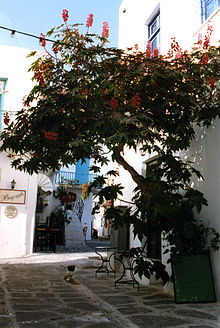
AlthoughRicinus communisis indigenous to the southeasternMediterranean Basin,Eastern Africa,and India, today it is widespread throughout tropical regions.[5]In areas with a suitable climate, castor establishes itself easily where it can become an invasive plant and can often be found on wasteland.
It is also used extensively as a decorative plant in parks and other public areas, particularly as a "dot plant" in traditionalbedding schemes.If sown early, under glass, and kept at a temperature of around 20 °C (68 °F) until planted out, the castor oil plant can reach a height of 2–3 metres (6.6–9.8 ft) in a year. In areas prone tofrostit is usually shorter, and grown as if it were anannual.[5]However, it can grow well outdoors in cooler climates, at least in southern England, and the leaves do not appear to suffer frost damage in sheltered spots, where it remains evergreen.[15]It was used in Edwardian times in the parks of Toronto, Canada. Although not cultivated there, the plant grows wild in the US, notablyGriffith Parkin Los Angeles.[16]
Cultivars
[edit]Cultivarshave been developed by breeders for use as ornamental plants (heights refer to plants grown as annuals) and for commercial production of castor oil.[7]
- Ornamental cultivars
- 'Carmencita' has gained theRoyal Horticultural Society'sAward of Garden Merit[17][18]
- 'Carmencita Bright Red' has red stems, dark purplish leaves and red seed pods;
- 'Carmencita Pink' has green leaves and pink seed pods
- 'Gibsonii' has red-tinged leaves with reddish veins and bright scarlet seed pods
- 'New Zealand Purple' has plum colored leaves tinged with red, plum colored seed pods turn to red as they ripen
- (All the above grow to around 1.5 metres (4.9 ft) tall as annuals.)[5]
- 'Impala' is compact (only 1.2 metres or 3.9 feet tall) with reddish foliage and stems, brightest on the young shoots
- 'Red Spire' is tall (2–3 metres or 6.6–9.8 feet) with red stems and bronze foliage
- 'Zanzibarensis' is also tall (2–3 metres or 6.6–9.8 feet), with large, mid-green leaves (50 centimetres or 20 inches long) that have white midribs[7]
- Cultivars for oil production
- 'Hale' was launched in the 1970s for the US state of Texas.[19]It is short (up to 1.2 m or 3 ft 11 in) and has several racemes
- 'Brigham' is a variety with reduced ricin content adapted for Texas, US. It grows up to 1.8 m (5 ft 11 in) and has 10% of the ricin content of 'Hale'
- 'BRS Nordestina' was developed by Brazil'sEmbrapain 1990 for hand harvest and semi-arid environments
- 'BRS Energia "was developed by Embrapa in 2004 for mechanised or hand harvest
- 'GCH6' was developed bySardarkrushinagar Dantiwada University,India, 2004: it is resistant to root rot and tolerant tofusarium wilt
- 'GCH5' was developed by Sardarkrushinagar Dantiwada University, 1995. It is resistant to fusarium wilt
- 'Abaro' was developed by theEthiopian Institute of Agricultural Research's Essential Oils Research Center for hand harvest
- 'Hiruy' was developed by the Ethiopian Institute of Agricultural Research'sMelkassaandWondo GenetAgricultural Research Centers for hand harvest during 2010/2011
Allergenicity and toxicity
[edit]Ricinusis extremely allergenic, and has anOPALSallergy scale rating of 10 out of 10. The plant is also a very strong trigger for asthma, and allergies toRicinusare commonplace and severe.[20]
The castor oil plant produces abundant amounts of very light pollen, which easily become airborne and can be inhaled into the lungs, triggering allergic reactions. The sap of the plant causes skin rashes. People who are allergic to the plant can also develop rashes from touching the leaves, flowers, or seeds. They can also have cross-allergic reactions tolatexsap from the relatedHevea brasiliensisplant.[20]
The toxicity of raw castor beans is due to the presence ofricin.Although the lethal dose in adults is considered to be four to eight seeds, reports of actual poisoning are relatively rare.[21]According to theGuinness World Records,this is the world's most poisonous common plant.[22]
If ricin is ingested, symptoms commonly begin within two to four hours, but may be delayed by up to 36 hours. These include a burning sensation in mouth and throat, abdominal pain, purging and bloody diarrhea. Within several days there is severe dehydration, a drop in blood pressure and a decrease in urine. Unless treated, death can be expected to occur within 3–5 days; however, in most cases a full recovery can be made.[23][24]
Poisoning occurs when animals, including humans, ingest broken castor beans or break theseedby chewing: intact seeds may pass through the digestive tract without releasing the toxin.[23]The toxin provides the castor oil plant with some degree of natural protection from insect pests such asaphids.Ricin has been investigated for its potential use as aninsecticide.[25]
Commercially available cold-pressed castor oil is not toxic to humans in normal doses, whether internal or external.[26]
Uses
[edit]Folk medicine
[edit]Castor oil and the plant's roots and leaves are used in the ancient Indian medicinal system ofAyurveda.
Modern commercial usage
[edit]Global castor seed production is around two million tons per year. Leading producing areas are India (with over three-quarters of the global yield), China and Mozambique, and it is widely grown as a crop in Ethiopia. There are several active breeding programmes.
| Country | Production (tonnes) | Footnote | ||
|---|---|---|---|---|
| India | 1,196,680 | |||
| Mozambique | 85,089 | F | ||
| China | 36,000 | * | ||
| Brazil | 16,349 | |||
| Ethiopia | 11,157 | * | ||
| Vietnam | 7,000 | * | ||
| South Africa | 6,721 | F | ||
| Paraguay | 6,000 | * | ||
| Thailand | 1,588 | * | ||
| Pakistan | 1,107 | * | ||
| World | 1,407,588 | A | ||
| No symbol = official figure, F = FAO estimate, * = Unofficial/Semi-official/mirror data, A = Aggregate (may include official, semi-official or estimates) | ||||
Other modern uses of natural, blended, or chemically altered castor products include:
- As a non-freezing,antimicrobial,pressure-resistant lubricant for special purposes, either of latex or metals, or as a lubricating component of fuels.[27]
- As sources of various chemicalfeedstocks.[28]
- As a raw material for some varieties ofbiodiesel.
- As attractively patterned, low-cost personal adornments, such as non-durable necklaces and bracelets. Holes must not be drilled in the beans to make beads. The outer shell protects the wearer from the poison. Wearing castors beans has been known to cause rashes, and worse.
- As a component of many cosmetics.
- As an anti-microbial. The high percentage ofricinoleic acidresidues in castor oil and its derivatives, inhibits many microbes, whether viral, bacterial or fungal. They accordingly are useful components of many ointments and similar preparations.
- As the major raw material (in oil form) forpolyglycerol polyricinoleate,a modifier that improves the flow characteristics ofcocoa butterin the manufacture ofchocolate bars,and thereby reduces the costs.
- As a repellent formolesandvolesin lawns.
Historical usage
[edit]Ancient uses
[edit]Castor seeds have been found inEgyptiantombs dating back to 4000 BC; the slow-burning oil was mostly used to fuel lamps.Herodotusand otherGreektravellers noted the use of castor seed oil for lighting, body ointments, and improving hair growth and texture.Cleopatrais reputed to have used it to brighten the whites of her eyes. TheEbers Papyrusis an ancient Egyptian medical treatise believed to date from 1552 BC. Translated in 1872, it describes castor oil as alaxative.[29]
The use of castor bean oil (eranda) in India has been documented since 2000 BC in lamps and in local medicine as a laxative,purgative,andcatharticinUnani,Ayurvedic,siddhaand otherethnomedicalsystems. Traditional Ayurvedic andsiddha medicineconsiders castor oil the king of medicinals for curingarthritic diseases.It is regularly given to children to treat infections with parasitic worms.[30]
The ancient Romans had a variety of medicinal/cosmetic uses for both the seeds and the leaves ofRicinus communis.The naturalistPliny the Eldercited the poisonous qualities of the seeds, but mentioned that they could be used to form wicks for oil lamps (possibly if crushed together), and the oil for use as a laxative and lamp oil.[31]He also recommends the use of the leaves as follows:
"The leaves are applied topically with vinegar forerysipelas,and fresh-gathered, they are used by themselves for diseases of the mamillæ [breasts] and de- fluxions; a decoction of them in wine, withpolentaandsaffron,is good for inflammations of various kinds. Boiled by themselves, and applied to the face for three successive days, they improve the complexion. "[32]
InHaitiit is calledmaskreti,[33]where the plant is turned into a red oil that is then given to newborns as apurgativeto cleanse the insides of their first stools.[34]
Castor seed and its oil have also been used in China for centuries, mainly prescribed in local medicine for internal use or use in dressings.[35]
Uses in punishment
[edit]Castor oil was used as an instrument of coercion by the paramilitaryBlackshirtsunder the regime ofItaliandictatorBenito Mussoliniand by theSpanish Civil Guardin Francoist Spain. Dissidents and regime opponents were forced to ingest the oil in large amounts, triggering severediarrheaanddehydration,which could ultimately cause death. This punishment method was originally thought of byGabriele D'Annunzio,the Italian poet and Fascist supporter, during theFirst World War.[36]
Other uses
[edit]Extract ofRicinus communisexhibitedacaricidalandinsecticidalactivities against the adult ofHaemaphysalis bispinosa(Acarina:Ixodidae) andhematophagousflyHippobosca maculata(Diptera:Hippoboscidae).[37]
Members of the Bodo tribe ofBodolandinAssam,India, use the leaves of the plant to feed thelarvaeofmugaandendisilkworms.
Castor oil is an effective motor lubricant and has been used ininternal combustion engines,including those ofWorld War Iairplanes, some racing cars and somemodel airplanes.It has historically been popular for lubricatingtwo-stroke enginesdue to high resistance to heat compared to petroleum-based oils. It does not mix well with petroleum products, particularly at low temperatures, but mixes better with the methanol-based fuels used inglow model engines.Intotal-loss-lubricationapplications, it tends to leave carbon deposits and varnish within the engine. It has been largely replaced by synthetic oils that are more stable and less toxic.
Jewellerycan be made of castor beans, particularly necklaces and bracelets.[38]Holes must not be drilled into the castor beans as the shell protects the wearer from the ricin.[citation needed]Any chips in the shell can cause poisoning of the wearer.[citation needed]Pets who chew the jewellery can become ill.[38]
Ricinus communisleaves are used in botanical printing (also known as ecoprinting) in Asia. When bundled with cotton or silk fabric and steamed, the leaves can produce a green-colored imprint.[39][better source needed]
See also
[edit]References
[edit]- ^USDA, NRCS(n.d.)."Ricinus communis".The PLANTS Database (plants.usda.gov).Greensboro, North Carolina: National Plant Data Team.Retrieved1 February2016.
- ^"Ricinus communis:Castor oil plant ".Oxford University Herbaria.Dept. of Plant Sciences, Oxford.
The castor oil plant is one of the few major crops to have an origin in Africa.
- ^"Euphorbiaceae (spurge) genomics".Institute for Genome Sciences.University of Maryland Medical School.Retrieved9 March2009.
- ^Rizzardo, RA; Milfont, MO; Silva, EM; Freitas, BM (December 2012)."Apis melliferapollination improves agronomic productivity of anemophilous castor bean (Ricinus communis) ".Anais da Academia Brasileira de Ciências.84(4): 1137–45.doi:10.1590/s0001-37652012005000057.PMID22990600.
- ^abcdPhillips, Roger; Rix, Martyn (1999).Annuals and Biennials.London: Macmillan. p. 106.ISBN978-0-333-74889-3.
- ^e.g."PROTA published species".Archived fromthe originalon 4 May 2010.Retrieved21 April2010.
- ^abcChristopher Brickell, ed. (1996).The Royal Horticultural Society A-Z Encyclopedia of Garden Plants.London:Dorling Kindersley.pp. 884–885.ISBN978-0-7513-0303-2.
- ^Tan Q.-G.; Cai X.-H.; Dua Z.-Z.; Luo X.-D. (2009). "Three terpenoids and a tocopherol-related compound fromRicinus communis".Helvetica Chimica Acta.92(12): 2762–8.doi:10.1002/hlca.200900105.
- ^Srivastava, Pooja; Jyotshna; Gupta, Namita; Kumar Maurya, Anil; Shanker, Karuna (2013). "New anti-inflammatory triterpene from the root of Ricinus communis".Natural Product Research.28(5): 306–311.doi:10.1080/14786419.2013.861834.PMID24279342.S2CID36797216.
- ^Charles de Geer, 1752-1778Mémoires pour servir à l'histoire des insectes,digital facsimile at theGallicawebsite.
- ^Oliver, Paul M.; Lee, Michael S.Y. (2010). "The botanical and zoological codes impede biodiversity research by discouraging publication of unnamed new species".Taxon.59(4): 1201–1205.doi:10.1002/tax.594020.ISSN0040-0262.
- ^"Animal Nomenclature".projects.ncsu.edu.Retrieved4 August2020.
- ^"The Complex Case of Castor's Etymology".Archived fromthe originalon 3 February 2011.
- ^Cross, Fiona R., and Robert R. Jackson. "Odour‐mediated response to plants by evarcha culicivora, a blood‐feeding jumping spider from East Africa." New Zealand Journal of Zoology 36.2 (2009): 75-80.
- ^"Castor Bean, Ricinus communis".Master Gardener Program.Retrieved4 August2020.
- ^Toronto Star,9 June 1906, p. 17
- ^"RHS Plantfinder –Ricinus communis'Carmencita'".Retrieved9 October2018.
- ^"AGM Plants – Ornamental"(PDF).Royal Horticultural Society. July 2017. p. 88.Retrieved9 October2018.
- ^The Cattleman.1961. p. 126.
"Hale" is a dwarf-internode castor bean variety developed in the cooperative castorbean program of theUnited States Department of Agricultureand theTexas Agricultural Experiment Station.It is resistant to bacterialleaf spotandAlternarialeaf spot
- ^abOgren, Thomas (2015).The Allergy-Fighting Garden.Berkeley, CA: Ten Speed Press. pp. 184–185.ISBN978-1-60774-491-7.
- ^Wedin GP, Neal JS, Everson GW, Krenzelok EP (May 1986). "Castor bean poisoning".Am J Emerg Med.4(3): 259–61.doi:10.1016/0735-6757(86)90080-X.PMID3964368.
- ^Guinness World Records 2017.London, UK: Guinness World Records Limited. 2016. p. 43.
- ^abSoto-Blanco B, Sinhorini IL, Gorniak SL, Schumaher-Henrique B (June 2002). "Ricinus communiscake poisoning in a dog ".Vet Hum Toxicol.44(3): 155–6.PMID12046967.
- ^Ricinus communis(Castor bean)—Cornell University2008."Castorbean".Archived fromthe originalon 8 May 1998.
- ^Union County College: Biology: Plant of the Week: Castor Bean PlantArchived24 May 2013 at theWayback Machine
- ^Irwin R (March 1982). "NTP technical report on the toxicity studies of Castor Oil (CAS No. 8001-79-4) In F344/N Rats And B6C3F1 Mice (Dosed Feed Studies)".Toxic Rep Ser.12:1–B5.PMID12209174.
- ^R. M. Mortier; S. T. Orszulik (6 December 2012).Chemistry and Technology of Lubricants.Springer. pp. 226–.ISBN978-1-4615-3272-9.
- ^Castor Oil World
- ^Tunaru, S; Althoff, TF; Nusing, RM; Diener, M; Offermanns, S (2012)."Castor Oil Induces Laxation and Uterus Contraction via Ricinoleic Acid Activating Prostaglandin EP3 Receptors".Proceedings of the National Academy of Sciences of the United States of America.109(23): 9179–9184.Bibcode:2012PNAS..109.9179T.doi:10.1073/pnas.1201627109.PMC3384204.PMID22615395.
- ^Rekha, D. (2013). "Study of medicinal plants used from koothanoallur and marakkadai, Thiruvarur district of Tamil Nadu, India".Hygeia Journal for Drugs and Medicines.5(1): 164–170.
- ^John Bostock & H.T. Riley (1855)."Pliny, the Natural History Chapter 41. – Castor Oil, 16 Remedies".
- ^Pliny the Elder.Natural History.p. Chapter 41, Book 23.41.
- ^Quiros-Moran, Dalia, ed. (2009).Guide to Afro-Cuban Herbalism.AuthorHouse. p. 347.ISBN9781438980973.Retrieved5 August2017.
- ^Auvenshine, Martha Ann; Enriquez, Martha Gunther, eds. (1990).Comprehensive Maternity Nursing: Perinatal and Women's Health.Jones and Bartlett Publishers. p. 122.ISBN9780867204216.Retrieved5 August2017.
- ^Scarpa, Antonio; Guerci, Antonio (1982). "Various uses of the castor oil plant (Ricinus communis L.) a review".Journal of Ethnopharmacology.5(2): 117–137.doi:10.1016/0378-8741(82)90038-1.ISSN0378-8741.PMID7035750.
- ^Petersen, Jens (1982), "Violence in Italian Fascism, 1919–25",Social Protest, Violence and Terror in Nineteenth- and Twentieth-century Europe,London: Palgrave Macmillan UK, pp. 275–299,doi:10.1007/978-1-349-16941-2_17,ISBN978-1-349-16943-6
- ^Zahir AA, Rahuman AA, Bagavan A, et al. (August 2010). "Evaluation of botanical extracts againstHaemaphysalis bispinosaNeumann andHippobosca maculataLeach ".Parasitology Research.107(3): 585–92.doi:10.1007/s00436-010-1898-7.PMID20467752.S2CID20498642.
- ^ab"Growing danger: Toxic plants pose pet threat".NBC News.10 June 2009. Archived fromthe originalon 11 May 2014.
- ^how to make ECOPRINT DIY,3 September 2019,retrieved23 October2022
Further reading
[edit]- Everitt, J.H.; Lonard, R.L.; Little, C.R. (2007).Weeds in South Texas and Northern Mexico.Lubbock: Texas Tech University Press.ISBN978-0-89672-614-7.
External links
[edit]- RicinusatCurlie
- A Bean Called Castor Can Cut Carbon & Fuel the Future
- Ricinus communis L.– at Purdue University
- Castor beans– at Purdue University
- Ricinus communis(castor bean)at Cornell University
- Ricinus communisin Wildflowers of Israel
- Castor oil plantFlowers in Israel

